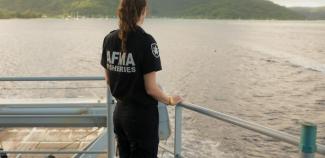
News
Video tapes of David Attenborough and Les Hiddins led to an evolving career in fisheries
As Senior Fisheries Officer Emily has discovered, a background in science can lead to a rich and challenging career path. To celebrate National Science Week 2020, we had a yarn with Emily about how she first became interested in a career on the sea and how science and technology help AFMA to manage Australia’s fisheries sustainably.
- What first interested you in science and the marine world?
My fascination stemmed from watching episodes of David Attenborough and Les Hiddins on VHS tapes, showing me the natural world beyond the limits of inner city Sydney. I didn’t realise my career choice until I moved from the city and took up a job in dune and coastal regeneration in northern NSW. I loved it and knew if I could create the opportunity, I'd like to spend more time around the sea.
- What did you study at university?
Bachelor of Applied Sciences with honours in Marine Science and Management.
- How did you come to work at AFMA?
I’ve been in the fisheries world since beginning a university internship with NSW Fisheries. From there I worked for NT Fisheries, then back down to the Department of Agriculture, Water and the Environment in Canberra and presently back up to the NT with AFMA. With AFMA I could mix practical on-water compliance and conservation activities with a bit of research and policy.
- What is your current role at AFMA?
Senior Fisheries Officer in International Compliance Operations, based in Darwin.
- How is science and/or technology important to your day to day work?
Science and innovative technology can solve great challenges in fisheries and ocean conservation. Science based decisions set the fundamental standards in fisheries management and technology is integral for maximising the data and information we collect, to base those decisions on. For example, in tuna fisheries, by-catch mitigation measures for seabirds and turtle are determined through science and the technology helps us protect them. There’s a technology race with electronic monitoring and AI surveillance for both above and below the ocean surface at the moment, it is a daily developing space to watch.